-
 Bitcoin
Bitcoin $83,080.8873
-1.14% -
 Ethereum
Ethereum $1,791.4746
-1.45% -
 Tether USDt
Tether USDt $0.9998
0.02% -
 XRP
XRP $2.1324
-0.13% -
 BNB
BNB $592.0388
-1.08% -
 Solana
Solana $119.1957
-3.22% -
 USDC
USDC $1.0001
0.01% -
 Dogecoin
Dogecoin $0.1681
-1.64% -
 Cardano
Cardano $0.6497
-1.94% -
 TRON
TRON $0.2375
-0.61% -
 UNUS SED LEO
UNUS SED LEO $9.0588
-4.96% -
 Chainlink
Chainlink $12.6860
-2.48% -
 Toncoin
Toncoin $3.2620
-3.95% -
 Stellar
Stellar $0.2511
-3.60% -
 Avalanche
Avalanche $17.8165
-2.01% -
 Shiba Inu
Shiba Inu $0.0...01230
-0.03% -
 Sui
Sui $2.2118
-2.95% -
 Hedera
Hedera $0.1616
-2.22% -
 Litecoin
Litecoin $82.0450
-2.73% -
 Polkadot
Polkadot $3.9414
-2.77% -
 MANTRA
MANTRA $6.2727
-0.36% -
 Bitcoin Cash
Bitcoin Cash $300.4768
-0.31% -
 Dai
Dai $1.0001
0.02% -
 Bitget Token
Bitget Token $4.4469
-1.89% -
 Ethena USDe
Ethena USDe $0.9991
0.00% -
 Pi
Pi $0.5875
11.07% -
 Hyperliquid
Hyperliquid $11.8527
-4.06% -
 Monero
Monero $214.0698
-0.86% -
 Uniswap
Uniswap $5.8104
-2.14% -
 OKB
OKB $51.8157
5.85%
What is the difference between public chain, private chain and consortium chain?
Public, private, and consortium blockchains offer varying degrees of decentralization and control. Public chains prioritize decentralization and transparency, while private chains offer speed and control, and consortium chains balance both.
Feb 27, 2025 at 05:30 am
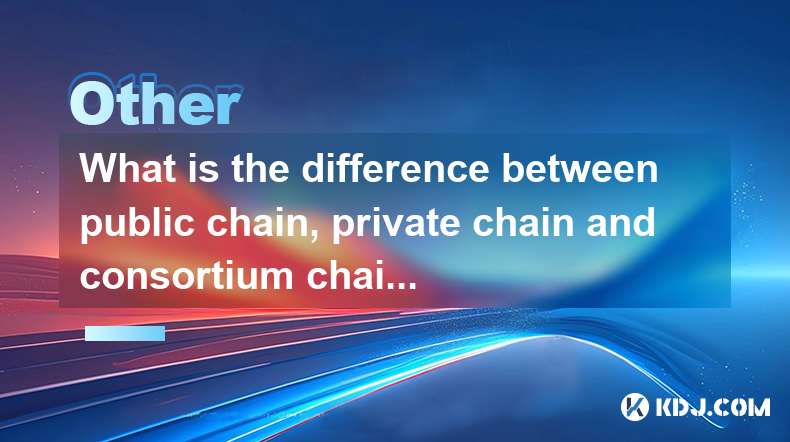
What is the difference between public chain, private chain and consortium chain?
Key Points:
- Public Chains: Highly decentralized, permissionless, transparent, and secure networks accessible to everyone. Security relies on a distributed consensus mechanism, often requiring significant computational resources. Examples include Bitcoin and Ethereum. The trade-off is often slower transaction speeds and higher fees compared to private or consortium chains.
- Private Chains: Centralized, permissioned networks controlled by a single entity or organization. They offer greater control, faster transaction speeds, and potentially lower fees. However, they lack the transparency and decentralization of public chains, making them vulnerable to single points of failure and censorship.
- Consortium Chains: Hybrid approach combining elements of public and private chains. A group of pre-selected organizations jointly govern the network, balancing decentralization with control and efficiency. Transaction speeds and fees typically fall between public and private chains. They offer a compromise between security, speed, and control.
I. Public Chains: The Decentralized Frontier
- A public blockchain is a distributed ledger technology (DLT) that is open and accessible to anyone. This means that anyone can participate in the network, whether it's by validating transactions, creating new blocks, or simply viewing the blockchain's data. This open architecture is a cornerstone of decentralization, a key feature that distinguishes public blockchains from their private and consortium counterparts. The decentralized nature enhances the security and resilience of the network, making it less susceptible to single points of failure or manipulation by a central authority. Each node in the network holds a copy of the entire blockchain, creating a distributed consensus mechanism that requires malicious actors to control a significant portion of the network to alter the blockchain's data. This high level of security, however, often comes at a cost. The need to reach consensus among many independent nodes can lead to slower transaction processing speeds and potentially higher transaction fees compared to private or consortium chains.
- The consensus mechanisms employed by public blockchains are crucial to their operation. Proof-of-Work (PoW), a prominent example, involves nodes competing to solve complex cryptographic puzzles to validate transactions and add new blocks to the chain. This process requires significant computational power, leading to high energy consumption and potentially higher transaction fees. Proof-of-Stake (PoS) is another popular consensus mechanism that rewards validators based on the amount of cryptocurrency they stake, reducing the energy consumption compared to PoW. Regardless of the specific mechanism used, the goal remains the same: to ensure the integrity and security of the blockchain through a decentralized and transparent process. The transparency aspect of public chains is another critical feature. All transactions are recorded on the blockchain and are publicly verifiable, enhancing accountability and trust. However, this transparency can also be a double-edged sword, as it can reveal sensitive information about users if not carefully managed through techniques like zero-knowledge proofs or privacy-enhancing technologies.
- The very nature of public blockchains fosters a vibrant ecosystem of developers, users, and businesses. The open-source nature of many public blockchains encourages community participation and innovation, leading to the development of decentralized applications (dApps), smart contracts, and other innovative technologies. The accessibility and permissionless nature of these chains allows anyone to contribute to their development and utilize their functionalities. This accessibility and open nature are vital for promoting inclusivity and fostering a global, decentralized ecosystem. However, the lack of control and the inherent volatility of the cryptocurrency market can also present challenges for businesses and users who seek more stability and predictability. The scalability of public blockchains is another significant consideration. As the number of transactions increases, the network's capacity to handle them efficiently can become a bottleneck. Solutions like sharding and layer-2 scaling solutions are being actively explored to address this challenge and improve the overall performance and usability of public blockchains.
II. Private Chains: The Controlled Environment
- In stark contrast to the decentralized nature of public blockchains, private blockchains are centralized and permissioned. This means that access to the network is restricted to authorized participants only. A single entity or organization typically controls the network, granting or revoking access as needed. This centralized control offers several advantages, particularly in terms of speed and efficiency. Transaction processing speeds are generally much faster than on public blockchains because there's no need for consensus among many independent nodes. The network can process transactions quickly and efficiently, making it suitable for applications requiring low latency. This centralized control also simplifies the management and maintenance of the network, reducing the complexity and cost associated with managing a large, decentralized system. Furthermore, the private nature of the blockchain allows for greater control over data privacy and security. Sensitive information can be kept confidential within the network, without the risk of public exposure.
- However, the centralized nature of private blockchains also presents significant drawbacks. The lack of decentralization makes the network vulnerable to single points of failure. If the central authority controlling the network is compromised, the entire system could be at risk. The absence of transparency and the potential for censorship are also significant concerns. Transactions are not publicly verifiable, raising questions about accountability and trust. Participants must rely on the integrity of the central authority, which may not always be guaranteed. This lack of transparency can also hinder the development of a vibrant ecosystem around the blockchain, as it limits the participation of independent developers and users.
- The use cases for private blockchains are often found in situations where speed, efficiency, and data privacy are prioritized over decentralization and transparency. Supply chain management, internal record-keeping, and secure data sharing within an organization are some examples where private blockchains can be beneficial. However, it's important to weigh the trade-offs between the benefits of centralization and the risks associated with a lack of decentralization and transparency. The lack of a robust consensus mechanism can also raise concerns about the security and integrity of the data stored on the blockchain. Careful consideration should be given to the implementation of robust security measures to protect against potential attacks and vulnerabilities. The development of private blockchains requires expertise in blockchain technology and a clear understanding of the security implications of a centralized system.
III. Consortium Chains: Bridging the Gap
- Consortium blockchains represent a middle ground between public and private blockchains, combining elements of both. They are permissioned networks, meaning that access is restricted to a pre-selected group of participants, typically organizations or entities. However, unlike private blockchains, the network is governed by a consortium of these organizations, rather than a single entity. This shared governance structure allows for a degree of decentralization, while still maintaining control and efficiency. This shared governance model aims to balance the benefits of decentralization with the need for control and efficiency. The consortium members collectively participate in validating transactions and maintaining the network's integrity. This shared responsibility enhances security and reduces the risk of a single point of failure.
- The transaction speeds and fees on consortium blockchains typically fall between those of public and private chains. They are generally faster than public chains but may not be as fast as private chains. Similarly, the fees are likely to be higher than private chains but lower than public chains. This makes them suitable for applications that require a balance between speed, efficiency, and security. The permissioned nature of consortium chains also offers greater control over data privacy and security compared to public chains. The consortium members can collectively agree on rules and regulations governing data access and usage.
- Consortium blockchains are particularly well-suited for applications requiring collaboration and trust among multiple organizations. Supply chain management, healthcare data sharing, and financial transactions are some examples where consortium blockchains can be highly beneficial. They provide a secure and transparent platform for multiple organizations to share data and collaborate, enhancing efficiency and trust. However, the management of a consortium blockchain can be complex, requiring coordination and agreement among the participating organizations. The governance structure must be clearly defined to avoid conflicts and ensure the smooth operation of the network. The selection of appropriate consensus mechanisms is also critical to the security and performance of the consortium blockchain. The choice will depend on the specific needs and requirements of the consortium.
FAQs:
Q: What are the key differences between public, private, and consortium blockchains in terms of security?
A: Public blockchains rely on a decentralized consensus mechanism (like PoW or PoS) for security, making them highly resistant to attacks. Private blockchains are vulnerable to single points of failure since a central authority controls them. Consortium blockchains offer a compromise, with shared governance enhancing security but still being less resistant than fully decentralized public chains.
Q: Which type of blockchain is best for a specific application?
A: The optimal choice depends on the application's requirements. If decentralization, transparency, and censorship resistance are paramount, a public blockchain is suitable. For applications prioritizing speed, efficiency, and control over data privacy, a private blockchain may be better. Consortium blockchains are ideal when collaboration among multiple organizations is needed while maintaining a degree of control and security.
Q: Can I transition from one type of blockchain to another?
A: No, you cannot directly transition from one type of blockchain to another. Each blockchain has its own architecture, consensus mechanism, and governance structure. Migrating data or functionality would require a significant development effort and is not a straightforward process. You would essentially need to build a new system on the target blockchain type.
Q: What are the future trends in public, private, and consortium blockchains?
A: Public blockchains are focusing on scalability and interoperability solutions. Private blockchains are exploring ways to enhance their security and transparency. Consortium blockchains are seeing increased adoption in various industries, with a focus on standardization and regulatory compliance. All three types are expected to see further integration with other technologies, such as IoT and AI.
Q: Are there any limitations to each type of blockchain?
A: Public blockchains face scalability challenges and can have high transaction fees. Private blockchains lack transparency and are vulnerable to single points of failure. Consortium blockchains require coordination among multiple organizations, which can be complex and lead to governance issues. Each type has trade-offs between decentralization, security, speed, and control.
Disclaimer:info@kdj.com
The information provided is not trading advice. kdj.com does not assume any responsibility for any investments made based on the information provided in this article. Cryptocurrencies are highly volatile and it is highly recommended that you invest with caution after thorough research!
If you believe that the content used on this website infringes your copyright, please contact us immediately (info@kdj.com) and we will delete it promptly.
- The US Government's Strategic Crypto Reserve Will Be Unveiled This Saturday
- 2025-04-06 05:40:12
- Fartcoin (FAR) price soared 32% to trade at $0.5155
- 2025-04-06 05:40:12
- If Shiba Inu Doubles the Market Cap of Dogecoin, It Could Move Close to Surpassing Its Previous All-Time High (ATH)
- 2025-04-06 05:35:12
- USDtb Breaks into the Top 10 Stablecoins by Market Cap, Tether Loses 60% of Market Dominance
- 2025-04-06 05:35:12
- Meme Coin Mayhem: Markets Stagger, But Troller Cat Roars Ahead
- 2025-04-06 05:30:12
- I'm known for my optimism. I try to give people something to build, not just something to worry about.
- 2025-04-06 05:30:12
Related knowledge

Is the ranking of Chinese blockchain apps real and reliable?
Apr 04,2025 at 09:01pm
The ranking of Chinese blockchain apps has become a topic of interest for many in the cryptocurrency community, as it provides insights into the popularity and adoption of blockchain technology within China. However, the reliability and authenticity of these rankings are often questioned. This article aims to delve into the factors that influence these ...
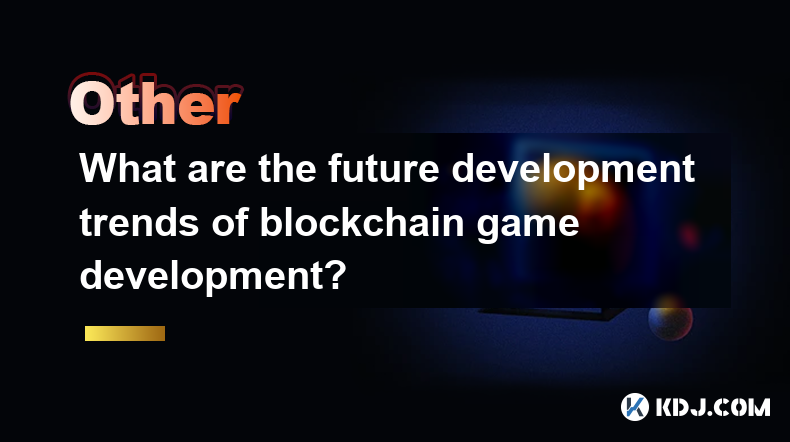
What are the future development trends of blockchain game development?
Apr 03,2025 at 05:00am
Blockchain technology has revolutionized various industries, and gaming is no exception. As we look to the future, several trends are set to shape the development of blockchain games. These trends not only promise to enhance the gaming experience but also to integrate blockchain technology more seamlessly into the gaming ecosystem. Let's explore these t...

What are the high-return opportunities for blockchain investments?
Apr 05,2025 at 02:35pm
Blockchain technology has revolutionized the financial world, offering numerous high-return investment opportunities. These opportunities span various sectors within the cryptocurrency ecosystem, including cryptocurrencies, decentralized finance (DeFi), non-fungible tokens (NFTs), and blockchain startups. Each of these areas presents unique risks and re...
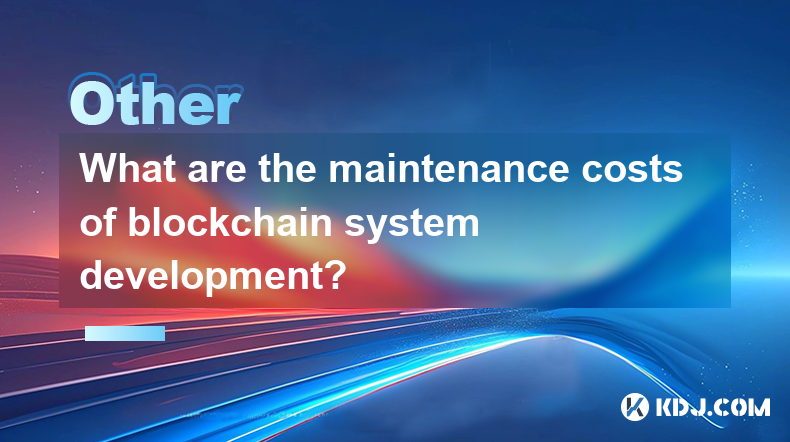
What are the maintenance costs of blockchain system development?
Apr 03,2025 at 06:07pm
The maintenance costs of blockchain system development are multifaceted and depend on various factors. These costs can include technical maintenance, security updates, infrastructure expenses, and personnel costs. Understanding these elements is crucial for anyone planning to develop or maintain a blockchain system. Technical MaintenanceTechnical mainte...
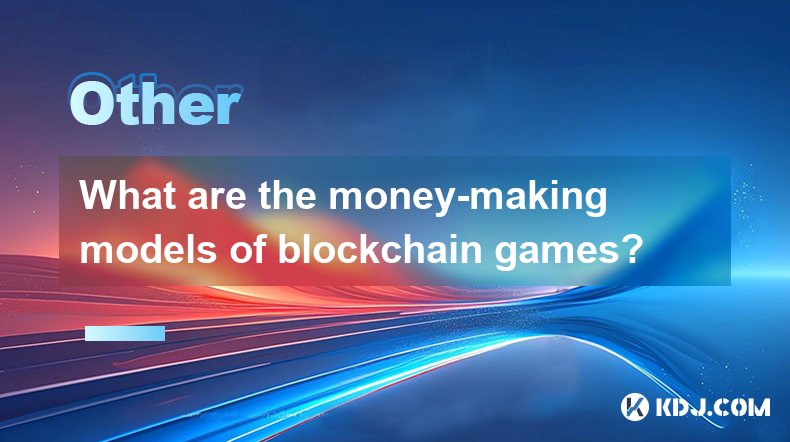
What are the money-making models of blockchain games?
Apr 04,2025 at 02:00pm
Blockchain games have emerged as a revolutionary way for players to earn real money while enjoying their favorite pastime. These games leverage the power of blockchain technology to create unique money-making models that benefit both the players and the developers. In this article, we will explore the various money-making models of blockchain games and ...
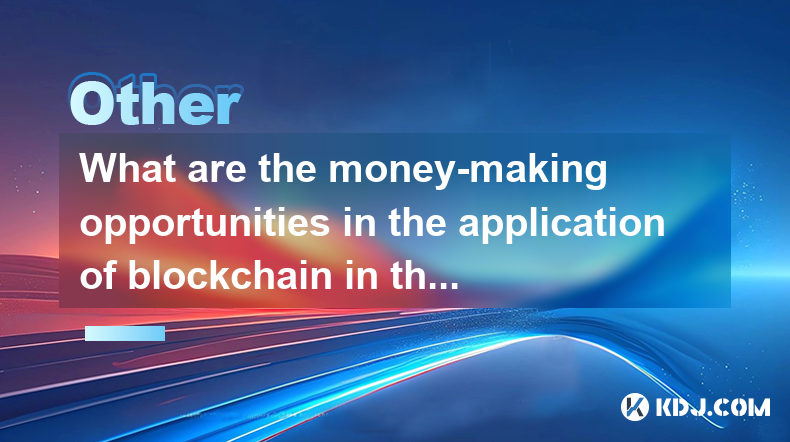
What are the money-making opportunities in the application of blockchain in the field of Internet of Things?
Apr 05,2025 at 10:35pm
The integration of blockchain technology with the Internet of Things (IoT) presents numerous money-making opportunities. Blockchain, with its decentralized and secure nature, can revolutionize how IoT devices interact, manage data, and conduct transactions. This article will explore various avenues where entrepreneurs, developers, and investors can capi...

Is the ranking of Chinese blockchain apps real and reliable?
Apr 04,2025 at 09:01pm
The ranking of Chinese blockchain apps has become a topic of interest for many in the cryptocurrency community, as it provides insights into the popularity and adoption of blockchain technology within China. However, the reliability and authenticity of these rankings are often questioned. This article aims to delve into the factors that influence these ...

What are the future development trends of blockchain game development?
Apr 03,2025 at 05:00am
Blockchain technology has revolutionized various industries, and gaming is no exception. As we look to the future, several trends are set to shape the development of blockchain games. These trends not only promise to enhance the gaming experience but also to integrate blockchain technology more seamlessly into the gaming ecosystem. Let's explore these t...

What are the high-return opportunities for blockchain investments?
Apr 05,2025 at 02:35pm
Blockchain technology has revolutionized the financial world, offering numerous high-return investment opportunities. These opportunities span various sectors within the cryptocurrency ecosystem, including cryptocurrencies, decentralized finance (DeFi), non-fungible tokens (NFTs), and blockchain startups. Each of these areas presents unique risks and re...

What are the maintenance costs of blockchain system development?
Apr 03,2025 at 06:07pm
The maintenance costs of blockchain system development are multifaceted and depend on various factors. These costs can include technical maintenance, security updates, infrastructure expenses, and personnel costs. Understanding these elements is crucial for anyone planning to develop or maintain a blockchain system. Technical MaintenanceTechnical mainte...

What are the money-making models of blockchain games?
Apr 04,2025 at 02:00pm
Blockchain games have emerged as a revolutionary way for players to earn real money while enjoying their favorite pastime. These games leverage the power of blockchain technology to create unique money-making models that benefit both the players and the developers. In this article, we will explore the various money-making models of blockchain games and ...

What are the money-making opportunities in the application of blockchain in the field of Internet of Things?
Apr 05,2025 at 10:35pm
The integration of blockchain technology with the Internet of Things (IoT) presents numerous money-making opportunities. Blockchain, with its decentralized and secure nature, can revolutionize how IoT devices interact, manage data, and conduct transactions. This article will explore various avenues where entrepreneurs, developers, and investors can capi...
See all articles





















































































